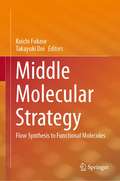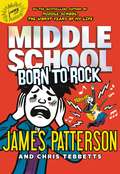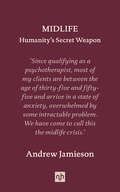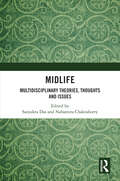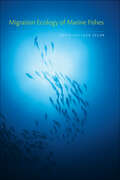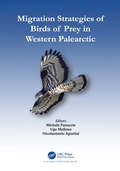- Table View
- List View
Middle Molecular Strategy: Flow Synthesis to Functional Molecules
by Koichi Fukase Takayuki DoiThis book highlights recently discovered aspects of “middle-size molecules,” focusing on (1) their unique bio-functions on the basis of derivatives and conjugates of natural products, saccharides, peptides, and nucleotides; (2) the synthesis of structurally complex natural products; (3) special synthetic methods for π-conjugated functional molecules; and (4) novel synthetic methods using flow chemistry. Given its scope, the book is of interest to industrial researchers and graduate students in the fields of organic chemistry, medicinal chemistry, and materials science.
Middle School: Born to Rock (Middle School #11)
by James Patterson Chris TebbettsIn the next book in James Patterson's bestselling Middle School series, Rafe Khatchadorian's hilarious little sister, Georgia, is back for another rollicking adventure! It's not easy being Rafe Khatchadorian's sister. He's got quite a reputation around school, and Georgia's got it hard enough as is! With a super secret crush on her classmate Sam Marks, a Rube Goldberg machine challenge to dominate, and constant confrontations with vicious Missy Trillin and her evil Princess Patrol to look forward to, Georgia can't help but throw all her energy into the one thing that makes her happy: her kick-butt, all-girl rock band, We Stink! When Georgia's favorite rock band, Lulu and the Handbags, advertise a major music competition where the winner gets to jam with Lulu herself, Georgia will pull all the stops to make sure We Stink wins--even if it means asking her annoying older brother, Rafe, for help! Will his crazy ideas work, or land her in serious trouble?
Midkine: From Embryogenesis to Pathogenesis and Therapy
by Takashi Muramatsu Mine Ergüven Ayhan BilirCarl Edward Sagan's (1934-1996) one of the famous quotation was "Who are we? We find that we live on an insignificant planet of a humdrum star lost in a galaxy tucked away in some forgotten corner of a universe in which there are far more galaxies than people." From past to date, well-known molecules, enzymes, proteins, lipids and carbohydrates are studied in the pathogenesis of several diseases both as a diagnostic/prognostic biomarker and therapeutic agent. The underlying mechanism of unexplained diseases and failure of therapies are frequently studied with well-known biomarkers, but remain unclear in many cases. As Dr. Sagan said other keys are still waiting to be known in some forgotten corner of a body universe, we find strength to propose that one of them can be the growth factor with cytokine activity named "Midkine" This book summarizes the extensive up-to-date literature overeview with the lastest work of experts about midkine in a detailed format that conveys its role as both a pathologic factor and therapeutic agent.
Midlands & Southern England (Regional Tramways)
by Peter WallerThis volume is the latest in a series of tramway books covering Britains post war tram networks. The book covers the systems that survived the Second World War, in the Midlands and Southern England, except London which will have a separate book.This extensive volume covers all the post war systems from their inception through to closure, with a superb range of images - many of which are previously unpublished - depicting each operation, from horse tram days through to the end. In addition, the comprehensive introduction provides an overview of the myriad other systems that once operated in the region but which did not survive after 1945, featuring such notable towns and cities as Bristol, Coventry and Norwich. Also included in the volume are accounts of the two second-generation systems to operate in the area: Midland Metro and Nottingham Express Transit.
Midlife: Humanity's Secret Weapon
by Andrew JamiesonA radical new take on one of humanity's most misunderstood periods of transition: the midlife crisis.Only two species of mammal have a post-reproductive life that lasts longer than their reproductive life: killer whales, whose elders are able to sniff out food supplies over vast oceanic distances to keep their pods fed, and Homo sapiens. While the evolutionary purpose of the killer whale&’s extensive life seems clear, what is the point of ours?This was a question that intrigued the psychoanalyst Carl Jung, who observed that if a culture is to maintain its deepest, profoundest roots while moving forward to embrace the challenges of historical and technological change, it needs to find an equilibrium between the energy, vigor, and creativity of those in the ego-driven first half of life and the experience, dignity, and wisdom of those in the second. But to make it to that second half of life, we need to traverse the dreaded middle years, when so many of us find ourselves discontented with our jobs, unhappy in our relationships, and lamenting our fetishized youths.In this highly readable and groundbreaking new book, the psychoanalyst Andrew Jamieson examines the Jungian concept of the midlife crisis to show how it is an essential evolutionary and social rite of passage that we all must proceed through—a set of challenges that we either take advantage of or ignore, depending on whether our complex or neurosis blocks this developmental impulse.Drawing on history, psychology, science, and literature, Jamieson shows just how ubiquitous, and crucial, the &“midlife crisis&” is, and the devastating consequences for society at large if we continue to regard it as something we can, and should, avoid.
Midlife: Multidisciplinary Theories, Thoughts and Issues
by Sanjukta Das and Nabamita ChakrabortyThis book is a rare and intriguing account of the midlife experience from a multidisciplinary perspective. It represents an insightful construal of midlife from the disciplines of philosophy, psychology, neuroscience, literature, sociology, and the fine arts. This volume provides an in-depth understanding of the middle phase of human lives which is the transitional phase at which a crucial transformation happens in the perspective towards life, society, and the world at large. It encompasses multiple methodological perspectives including empirical studies, descriptive and interpretative narratives, text analyses and revisiting existing literature. Since it addresses the issues of midlife from a multidisciplinary perspective, it would enable a wide variety of readers to connect with it. This book would be useful to the students, researchers and teachers of psychology, philosophy, neuroscience, literature, sociology, social work, film studies and the fine arts. It would also be an invaluable companion to professionals working in the field of Counselling Gerontology, Health and Social care, and NGOs.
Midnight in Chernobyl: The Untold Story of the World's Greatest Nuclear Disaster
by Adam HigginbothamA New York Times Best Book of the Year A Time Best Book of the Year A Kirkus Reviews Best Nonfiction Book of the Year 2020 Andrew Carnegie Medals for Excellence Winner One of NPR&’s Best Books of 2019 Journalist Adam Higginbotham&’s definitive, years-in-the-making account of the Chernobyl nuclear power plant disaster—and a powerful investigation into how propaganda, secrecy, and myth have obscured the true story of one of the twentieth century&’s greatest disasters.Early in the morning of April 26, 1986, Reactor Number Four of the Chernobyl Atomic Energy Station exploded, triggering history&’s worst nuclear disaster. In the thirty years since then, Chernobyl has become lodged in the collective nightmares of the world: shorthand for the spectral horrors of radiation poisoning, for a dangerous technology slipping its leash, for ecological fragility, and for what can happen when a dishonest and careless state endangers its citizens and the entire world. But the real story of the accident, clouded from the beginning by secrecy, propaganda, and misinformation, has long remained in dispute. Drawing on hundreds of hours of interviews conducted over the course of more than ten years, as well as letters, unpublished memoirs, and documents from recently-declassified archives, Adam Higginbotham has written a harrowing and compelling narrative which brings the disaster to life through the eyes of the men and women who witnessed it firsthand. The result is a masterful nonfiction thriller, and the definitive account of an event that changed history: a story that is more complex, more human, and more terrifying than the Soviet myth. Midnight in Chernobyl is an indelible portrait of one of the great disasters of the twentieth century, of human resilience and ingenuity, and the lessons learned when mankind seeks to bend the natural world to his will—lessons which, in the face of climate change and other threats, remain not just vital but necessary.
Migraine
by Oliver Sacks‘A mine of treasures, a source of visions, a microcosm of human experience and suffering, the philosopher’s stone: Migraineis a remarkable achievement’ Sunday Telegraph Migraine is an age-old – the first recorded instances date back over two thousand years – and often debilitating condition, affecting a ‘substantial minority’ of the population across the globe. In this book, Oliver Sacks offers at once a medical account of its occurrence and management; an exploration of its physical, physiological, and psychological underpinnings and consequences; and a meditation on the nature and experience of health and illness. ‘It delves into the workings of the brain with brilliant complexity, and should be required reading for migraine sufferers or those with an intellectual bent’ Cosmopolitan ‘Migraineis full of those wondrous insights that have made Oliver Sacks the most accessible and at the same time the most magisterial of doctors’ Anita Brookner, Spectator ‘Written with Sacks’s customary insight and grace, no book has helped me understand more about the mind-body connection’ Hilary Mantel, Mail on Sunday
Migraine
by Oliver SacksThe many manifestations of migraine can vary dramatically from one patient to another, even within the same patient at different times. Among the most compelling and perplexing of these symptoms are the strange visual hallucinations and distortions of space, time, and body image which migraineurs sometimes experience. Portrayals of these uncanny states have found their way into many works of art, from the heavenly visions of Hildegard von Bingen to Alice in Wonderland. Dr. Oliver Sacks argues that migraine cannot be understood simply as an illness, but must be viewed as a complex condition with a unique role to play in each individual's life.
Migration (Cycles of Nature)
by Jaclyn JaycoxZebras travel across the Kalahari Desert each spring in search of food. Whales swim to warmer water every winter. Take a journey to discover the wonders of migrating animals, including why they migrate and how far they travel.
Migration Ecology of Marine Fishes
by David Hallock SecorA revelatory look at the secrets of marine fish migration.Not since F. R. Harden Jones published his masterwork on fish migration in 1968 has a book so thoroughly demystified the subject. With stunning clarity, David Hallock Secor's Migration Ecology of Fishes finally penetrates the clandestine nature of marine fish migration. Secor explains how the four decades of research since Jones's classic have employed digital-age technologies—including electronic miniaturization, computing, microchemistry, ocean observing systems, and telecommunications—that render overt the previously hidden migration behaviors of fish. Emerging from the millions of observed, telemetered, simulated, and chemically traced movement paths is an appreciation of the individual fish. Members of the same populations may stay put, explore, delay, accelerate, evacuate, and change course as they conditionally respond to their marine existence. But rather than a morass of individual behaviors, Secor shows us that populations are collectively organized through partial migration, which causes groups of individuals to embark on very different migration pathways despite being members of the same population. Case studies throughout the book emphasize how migration ecology confounds current fisheries management. Yet, as Secor explains, conservation frameworks that explicitly consider the influence of migration on yield, stability, and resilience outcomes have the potential to transform fisheries management. A synthetic treatment of all marine fish taxa (teleosts and elasmobranchs), this book employs explanatory frameworks from avian and systems ecology while arguing that migrations are emergent phenomena, structured through schooling, phenotypic plasticity, and other collective agencies. The book provides overviews of the following concepts: • The comparative movement ecology of fishes and birds • The alignment of mating systems with larval dispersal • Schooling and migration as adaptations to marine food webs • Natal homing • Connectivity in populations and metapopulations • The contribution of migration ecology to population resilience
Migration Imaging of the Transient Electromagnetic Method
by Xiu Li Guoqiang Xue Changchun YinThis book is based on more than a decade of research the authors have pursued on the pseudo-seismic migration imaging of the transient electromagnetic method, and provides a series of important findings on the theory and applications in this area. It present and analyzes transforming principles, TEM wave field methods, characteristics of the TEM virtual wave field and studies on many significant related technologies. The coverage is supplemented by a wealth of 1-D, 2-D and 3-D figures to illustrate pseudo-seismic theory. The book offers a valuable resource for teachers, students, researchers and engineers in the fields of geophysics, earth exploration and information technology.
Migration Strategies of Birds of Prey in Western Palearctic
by Michele PanuccioGiven their roles in the ecosystem, raptors are widely considered the flagship or umbrella species among birds. Most species undertake a seasonal journey that is impressive because of the length, and the imposing natural barriers such as deserts and seas that they fly over. The migration of birds of prey has unique characteristics in the animal world because of their morphology and flight style. The flying path of Afro-Palearctic migrants between breeding and wintering grounds is determined by several factors such as morphology of the birds, geography, behavioural adaptations. The book analyses the migration patterns of raptors along the Afro-Palearctic migratory system, and summarizes the recent research on these top predator species. Behavioural adaptations such as the importance of social interactions and the modulation of the different flight styles as well as ecological interactions with the encountered environment and weather conditions en route are described in the book. Moreover, the impact of climate change on the migratory behaviour and key conservation issues are discussed. The book provides an overview of the migratory characteristics and flyway patterns of all European raptors species and also some Asian ones. These chapters have been written by some of the most important raptor specialists, giving a complete picture of the different migration strategies on the basis of both traditional methods and new technologies.
Migration and Environmental Change in Morocco: In search for Linkages Between Migration Aspirations and (Perceived) Environmental Changes (IMISCOE Research Series)
by Caroline Zickgraf Lore Van Praag Loubna Ou-Salah Elodie HutThis open access book studies the migration aspirations and trajectories of people living in two regions in Morocco that are highly affected by environmental change or emigration, namely Tangier and Tinghir, as well as the migration trajectories of immigrants coming from these regions currently living in Belgium. This book departs from the development of a new theoretical framework on the relationship between environmental changes and migration that can be applied to the Moroccan case. Qualitative research conducted in both countries demonstrate how the interplay between migration and environmental factors is not as straightforward as it seems, due to its wider social, political, economic, demographic and environmental context. Findings show how existing cultures of migration, remittances, views on nature and discourses on climate change create distinct abilities, capacities and aspirations to migrate due to environmental changes. The results illustrate how migration and environmental factors evolve gradually and mutually influence each other. In doing so, this book offers new insights in the ways migration can be seen as an adaptation strategy to deal with environmental change in Morocco.
Migration and Homing of Lymphoid Cells: Volume 1 (Routledge Revivals)
by Alan J. HusbandFirst published in 1988: This comprehensive set is crucial to the basic understanding of the immune system and is an essential component of the design and implementation of improved immunization strategies. Contains authoritative reviews of cell migration research and addresses the is-sues of lymphocyte recirculation leading to inductive interactions, and the subsequent migration and homing of effector cells generated from these responses. Systemic migration of cells from the central and peripheral lymphoid organs, the dichotomy of behavior between systemic and mucosal lymphoid cell pools, and explanations sought for mechanisms mediating selectivity of migration and homing are covered. This set is of interest to problem oriented scientists.
Migration and Radicalization: Global Futures
by Gabriel RubinThis book explores the connections between migration and terrorism and extrapolates, with the help of current research and case studies, what the future may hold for both issues. Migration and Radicalization: Global Futures looks at how migrants and terrorists have both been treated as Others outside the body politic, how growing migrant flows borne of a rickety state system cause both natives and migrants to turn violent, and how terrorist radicalization and tensions between natives and migrants can be reduced. As he contemplates potential global futures in the light of migration and radicalization, Gabriel Rubin charts a course between contemporary migration and terrorism scholarship, exploring their interactions in a methodologically rigorous but theoretically bold investigation.
Migration and the New Technological Borders of Europe
by Huub Dijstelbloem Albert MeijerEuropean borders that aim to control migration and mobility increasingly rely on technology to distinguish between citizens and aliens. This book explores new tensions in Europe between states and citizens, and between politics, technology and human rights.
Migration on Wings
by Lakshmi KanthaThis book is an effort to explore the technical aspects associated with bird flight and migration on wings. After a short introduction on the birds migration, the book reviews the aerodynamics and Energetics of Flight and presents the calculation of the Migration Range. In addition, the authors explains aerodynamics of the formation flight and finally introduces great flight diagrams.
Migration, Recognition and Critical Theory (Studies in Global Justice #21)
by Gottfried SchweigerThis book brings together philosophical, social-theoretical and empirically oriented contributions on the philosophical and socio-theoretical debate on migration and integration, using the instruments of recognition as a normative and social-scientific category. Furthermore, the theoretical and practical implications of recognition theory are reflected through the case of migration. Migration movements, refugees and the associated tensions are phenomena that have become the focus of scientific, political and public debate in recent years. Migrants, in particular refugees, face many injustices and are especially vulnerable, but the right-wing political discourse presents them as threats to social order and stability. This book shows what a critical theory of recognition can contribute to the debate. The book is suitable for researchers in philosophy, social theory and migration research. "A profound examination of how states and societies struggle to recognize migrants as fellow human beings in all their fullness. The contributions are exceptional for combining astute philosophy and social theory with a discussion of actual politics and real lives."Dr. Hugo Slim(Senior Research Fellow at the Blavatnik School of Government, University of Oxford and formerly Head of Policy at the International Committee of the Red Cross) “This impressive and timely volume offers an innovative way of understanding the issues of migration and integration by using a critical theory of recognition. Recognition theory has rich potential for effectively responding to the issues of autonomy, identity, integration, and empowerment that are at the core of the current public debates on mass migration, displacement, and the refugee crisis. By examining the normative and policy implications of recognition as they apply to migration, the book offers a pathbreaking look at the human dimension of the debate.”Dr. Helle Porsdam(Professor of Law and Humanities and UNESCO Chair in Cultural Rights University of Copenhagen)
Mike Holt's Illustrated Guide To Basic Electrical Theory
by Mike Holt Enterprises IncDo you know where electricity comes from? To be able to say yes to that question, you must understand a bit about the physics of matter. What value does a brief study of the nature of matter have for the student of electrical theory? The understanding that comes from that study lays the foundation for understanding electrical theory. Only when you know the theory can you truly have confidence in the practical aspects of your electrical work. This full-color textbook provides hundreds of illustrated graphics, detailed examples, practice questions, practice exams, summaries and a comprehensive practice final exam.
Mike Mulligan and His Steam Shovel
by Virginia Lee BurtonMike and his trusty steam shovel, Mary Anne, have a very important job. They dig deep canals for boats to travel through, cut mountain passes for trains, and hollow out cellars for big city skyscrapers- the very symbol of modern industrial America. But with progress comes new machines, and soon the inseparable duo are out of work. Mike believes that Mary Anne can dig as much in a day as a hundred men can dig in a week, and the two have one last chance to prove it and save Mary Anne from the scrap heap. What happens next in the small town of Popperville is a testament to their friendship, as well as old-fashioned hard work and ingenuity.
Mike Mulligan and His Steam Shovel
by Virginia Lee BurtonMike and his trusty steam shovel, Mary Anne, dig deep canals for boats to travel through, cut mountain passes for trains, and hollow out cellars for city skyscrapers -- the very symbol of industrial America. But with progress come new machines, and soon the inseparable duo are out of work. Mike believes that Mary Anne can dig as much in a day as one hundred men can dig in a week, and the two have one last chance to prove it and save Mary Anne from the scrap heap. What happens next in the small town of Popperville is a testament to their friendship, and to old-fashioned hard work and ingenuity.
Miko's Muzzy Mess (AstroKids #4)
by Robert ElmerWELCOME TO 2175! Meet the Astrokids--Miko, Buzz, Mir, DeeBee, and Tag--five friends learning biblical truth through out-of-this-world adventures aboard space station CLEO-7. Everyone thought I was the only stowaway on CLEO-7--until we found two muzzies hiding in the walls of the station. So cuddly and cute! What was to worry about? But with just a nibble of my chocolate bar, things got out of hand. Before long, the station was crawling with thousands of hungry muzzies. Yikes! And it was all my fault! Could we AstroKids catch all the muzzy invaders, or was this good-bye CLEO-7?
Mikro- und Ultrafiltration mit Membranen
by Siegfried RippergerMikro- und Ultrafiltration mit Membranen Klar strukturiert und kompakt wird hier die Mikro- und Ultrafiltration mit Membranen behandelt, von den Grundlagen und Charakterisierung von Membranen bis hin zu industriellen Anwendungen und Instandhaltung Die Mikro- und Ultrafiltration mit Membranen ist eine verbreitete und etablierte Schlüsseltechnologie für die Aufbereitung von Stoffströmen. Im Buch werden sowohl die Grundlagen der Mikro- und Ultrafiltration mit Membranen, Herstellung und Charakterisierung, Filtrationsverfahren, industrielle Anwendungen als auch die Instandhaltung und Reinigung von Membranen behandelt. Prinzipien und praktische Anwendungen werden klar strukturiert dem Leser zugänglich gemacht Behandelt alle Prozesse von Grundlagen bis zu den Anwendungen Unverzichtbar für die Ausarbeitung, Etablierung und Instandhaltung von Membrantrennverfahren Es bietet eine umfassende Einführung in die Theorie und Praxis der Membranfiltration und gibt wertvolle Einblicke in die verschiedenen Anwendungen und Technologien. Ob Sie nun ein erfahrener Ingenieur sind oder gerade erst in die Welt der Membranfiltration eintauchen, dieses Buch wird Ihnen helfen, Ihre Kenntnisse zu vertiefen und Ihre Fähigkeiten zu verbessern. Mit klaren Erklärungen, anschaulichen Beispielen und praktischen Tipps ist es ein unverzichtbares Nachschlagewerk für jeden, der sich mit der Filtration von Flüssigkeiten beschäftigt.
Mikrobielles Leben auf Fassaden
by Georg Gärtner Wolfgang Karl HofbauerArchitekten, Bauingenieure, Bausachverständige und andere Fachleute sowie Bauherren, Wissenschaftler und Masterstudenten finden in diesem Buch alle Informationen zu Fassadenalgen und -pilzen. Es gibt einen detaillierten Überblick über die Mikroorganismen, die das anfängliche Wachstum an den Außenfassaden von Gebäuden bilden und befasst sich mit den ökophysiologischen Eigenschaften, die die Rahmenbedingungen charakterisieren, unter denen diese Mikroorganismen an Fassaden auftreten können. Neben einem Bestimmungsschlüssel für die charakteristischen Anflüge an Fassaden von Mikroorganismen enthält dieses Buch eine ausführliche Beschreibung der einzelnen Organismen unter Angabe ihres ökologischen Verbreitungsgebiets. Darüber hinaus werden die verschiedenen ökologischen Parameter in kurzen Kapiteln diskutiert. Auch Maßnahmen zur Vorbeugung und Bekämpfung der Besiedelung von Fassaden mit Mikroorganismen werden thematisiert.
